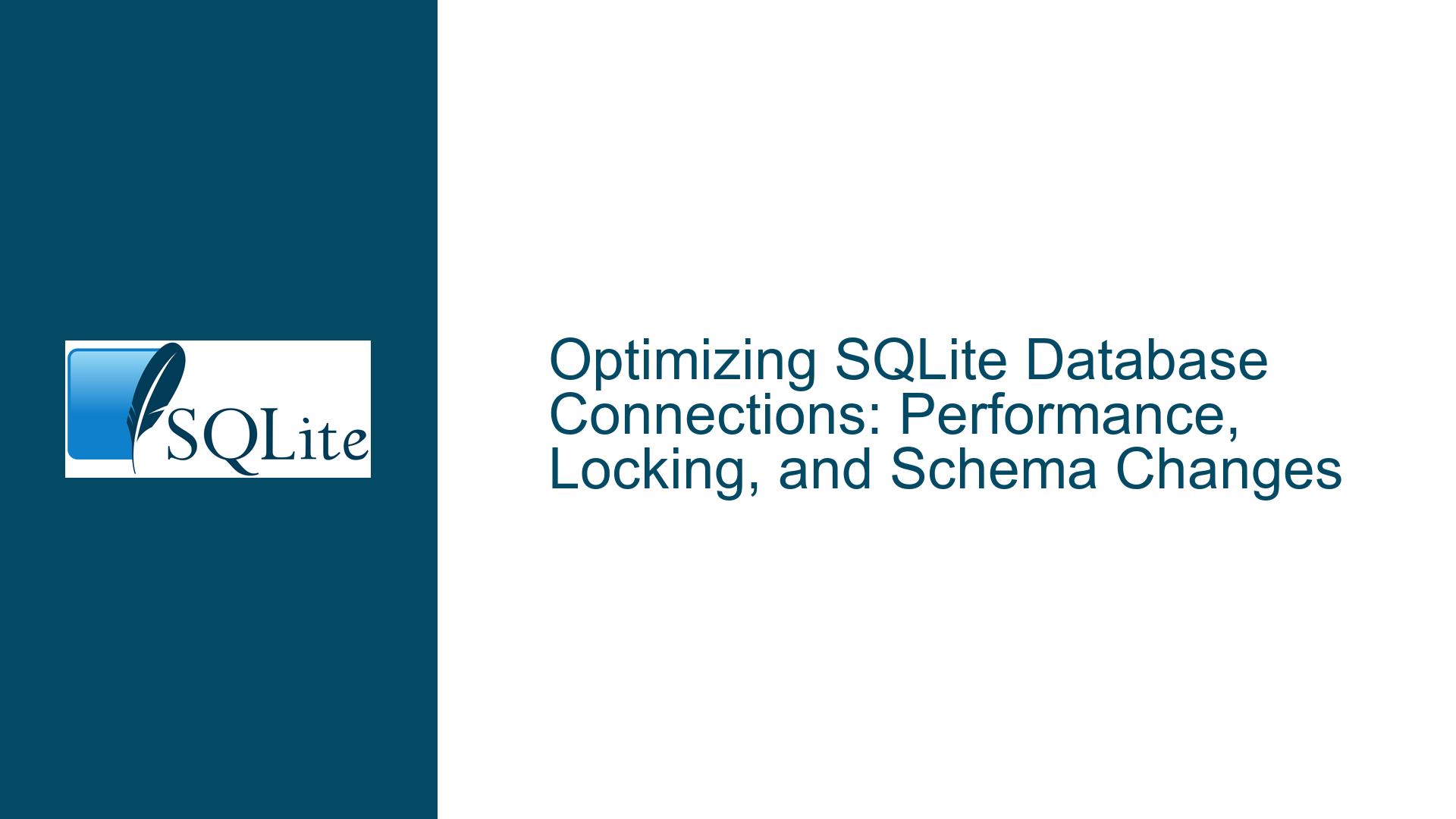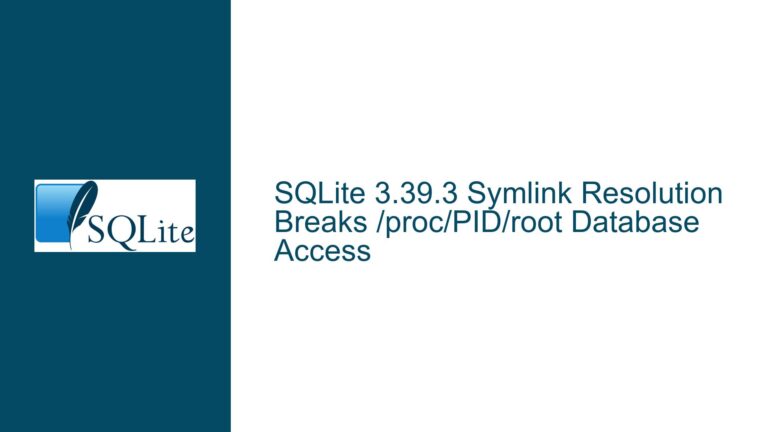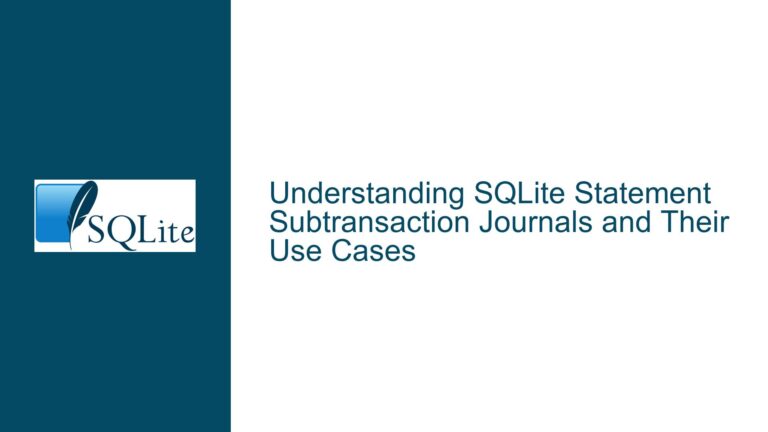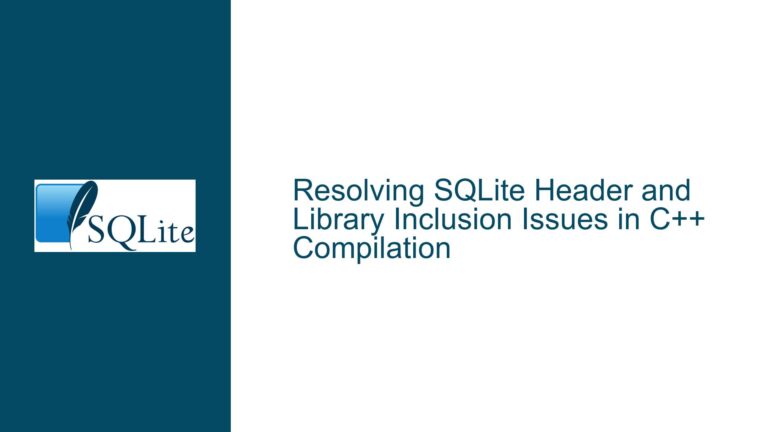Optimizing SQLite Database Connections: Performance, Locking, and Schema Changes
Understanding SQLite Database Connections and Their Implications
SQLite database connections are fundamental to interacting with the database, and understanding how they work is crucial for optimizing performance, avoiding deadlocks, and managing schema changes. A database connection in SQLite is represented by a pointer to a sqlite3 object, which serves as the gateway for executing SQL commands, managing transactions, and handling other database operations. The lifecycle of a connection—opening, using, and closing—has significant implications for application performance, concurrency, and data integrity.
When a connection is opened, SQLite performs several operations: it establishes file locks, reads and parses the database schema, and sets up memory mappings. These operations, while generally fast, can become bottlenecks in scenarios involving large schemas or high-frequency connection openings. Conversely, leaving a connection open for extended periods can lead to resource contention, especially when multiple connections attempt to access the same database simultaneously.
The behavior of SQLite connections is further influenced by the absence of a server architecture. Unlike client/server databases such as MySQL or PostgreSQL, SQLite operates directly on a file, relying on the operating system’s file locking mechanisms to manage concurrency. This design simplifies deployment but introduces unique challenges, particularly when handling schema changes or concurrent read/write operations.
Challenges with Multiple Connections and Schema Modifications
One of the primary concerns when working with SQLite is the management of multiple connections within a single application. Opening multiple connections can be necessary in certain scenarios, such as when performing schema changes or executing queries across attached databases. However, this approach is not without risks. Schema modifications, for instance, require exclusive access to the database. If a connection attempts to alter the schema while other connections are actively reading or writing, the operation will be blocked until all ongoing transactions complete. This can lead to significant delays, especially in applications with high concurrency or large datasets.
The performance trade-offs between opening and closing connections frequently versus maintaining a persistent connection are another critical consideration. While opening and closing connections for each operation can help avoid deadlocks and resource contention, it also incurs overhead due to the repeated initialization and cleanup processes. On the other hand, maintaining a single open connection can improve performance but may increase the risk of locking issues, particularly in multi-threaded applications.
SQLite’s reliance on file locking further complicates matters. The database uses shared and exclusive locks to manage concurrent access, but these locks are subject to the limitations of the underlying file system. For example, some file systems do not support granular locking, which can lead to unexpected behavior when multiple connections attempt to access the database simultaneously. Additionally, SQLite does not provide explicit control over locking mechanisms, unlike some other databases that offer features such as WITH NOLOCK in MS SQL Server.
Best Practices for Managing Connections and Schema Changes
To address these challenges, developers must adopt strategies that balance performance, concurrency, and data integrity. One effective approach is to minimize the frequency of connection openings and closings by maintaining a persistent connection for the duration of the application’s lifecycle. This reduces the overhead associated with initializing and tearing down connections and can significantly improve performance in scenarios involving frequent database access.
However, this strategy must be implemented carefully to avoid locking issues. For example, long-running transactions should be avoided, as they can block schema changes and other operations. Instead, transactions should be kept as short as possible, and operations that do not require transactional consistency should be executed outside of a transaction.
When schema changes are necessary, they should be performed during periods of low activity or scheduled to minimize disruption. Additionally, applications should be designed to handle potential delays gracefully, such as by implementing retry logic or providing feedback to users when operations are blocked.
For applications that require multiple connections, such as those involving attached databases or complex queries, it is essential to manage these connections carefully. Each connection should be used for a specific purpose, and operations that span multiple connections should be coordinated to avoid conflicts. For example, a connection dedicated to schema modifications should be opened only when necessary and closed immediately after the operation completes.
In conclusion, managing SQLite database connections effectively requires a deep understanding of the database’s architecture, locking mechanisms, and performance characteristics. By adopting best practices such as minimizing connection overhead, managing schema changes carefully, and coordinating multiple connections, developers can optimize their applications for performance, concurrency, and reliability. These strategies, combined with a thorough understanding of SQLite’s unique features and limitations, enable the creation of robust and efficient database-driven applications.






